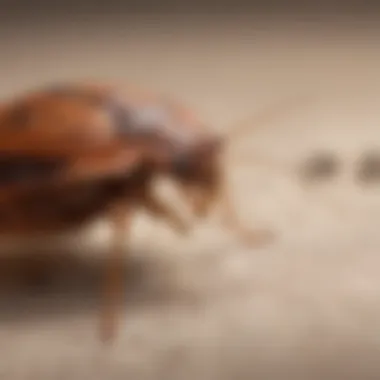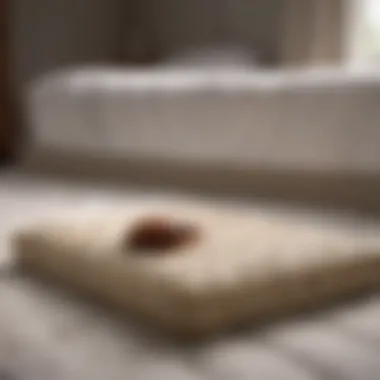Essential Steps for Addressing Bed Bug Discoveries


Intro
In recent years, bed bug infestations have surged dramatically, becoming a significant concern for families and professionals alike. Understanding the nature of these pests is crucial for effective management. This guide aims to shed light on bed bug identification, immediate actions to take upon discovery, and strategic long-term prevention methods. It also emphasizes when to engage professional exterminators to ensure complete eradication.
Animal Overview
Common Name and Scientific Classification
The common name for these pests is bed bugs, scientifically classified as Cimex lectularius. They are small, brownish insects that feed on the blood of humans and animals. Their size typically ranges from 4 to 5 mm in length, resembling an apple seed.
Physical Characteristics
Bed bugs possess a flat, oval body, making it easier for them to hide in crevices. They are wingless and have a somewhat segmented body structure. After feeding, their color changes to a reddish-brown, which is a clear indicator of their recent meal. They can be difficult to distinguish from other pests, so a thorough understanding of their appearance is key to identification.
Habitat and Distribution
Typically, bed bugs thrive in warm environments with ample hiding spots. They are often found in beds, mattresses, headboards, and furniture, as well as in cracks and seams of walls. Bed bugs can be transported by luggage, clothing, and furniture, leading to their rapid spread across various environments, inluding hotels, schools, and homes.
Behavior and Social Structure
Communication Methods
Bed bugs do not communicate using sounds or visual cues as other social insects might. Instead, they rely on chemical signals known as pheromones to communicate with each other, facilitating mating and alerting others to danger.
Social Hierarchies
Bed bugs are primarily solitary creatures. They do not exhibit a social structure like bees or ants. Their interactions are mainly focused on mating and feeding without a hierarchy.
Mating and Reproductive Behavior
Upon mating, female bed bugs lay up to five eggs a day, which can lead to exponential population growth if not controlled. The eggs are white and cling to surfaces, making them challenging to spot. They hatch into nymphs, further compounding the challenge of control and eradication.
Conservation Status
Current Population Trends
Unlike many species, bed bugs do not have a conservation status applicable through traditional environmental frameworks. They can freely adapt to diverse environments, contributing to their ongoing proliferation globally.
Threats and Challenges
The primary threat associated with bed bugs is their potential for rapid infestation within households. Their resilience against certain pesticides complicates elimination, as many treatments may be ineffective due to their ability to resist chemicals.
Conservation Efforts and Success Stories
While traditional conservation efforts don’t apply, public awareness campaigns and community initiatives focused on pest control education have shown success in reducing infestations. Many cities now offer resources for residents to understand pest management better, fostering a proactive approach to dealing with bed bugs.
Effective identification and immediate action are crucial in controlling bed bug infestations.
By being informed about the characteristics and behaviors of bed bugs, individuals can take necessary steps to prevent and manage infestations. This knowledge will be explored further in the upcoming sections.
Understanding Bed Bugs
Understanding bed bugs is a crucial first step in effectively managing their presence. These pests are not just a nuisance; they can impact mental and physical well-being. Knowing how they behave, where they live, and the signs of infestation is essential for timely intervention. The benefits of gaining knowledge about bed bugs include reducing anxiety, preventing further infestations, and protecting personal belongings. Consideration of their biology and habits allows for better strategic planning in both treatment and prevention.
Overview of Bed Bug Biology
Bed bugs, scientifically known as Cimex lectularius, are small insects that feed on the blood of humans and animals. Adults are about the size of an apple seed and possess a flattened, oval shape, making it easy for them to hide in tiny spaces. Their coloration ranges from light brown to reddish-brown, which darkens after feeding. Understanding their life cycle is vital; females can lay hundreds of eggs in a lifetime. A single female can instantiate a large population under optimal conditions. This knowledge enables individuals to appreciate the urgency in addressing an infestation promptly.


Common Habitats of Bed Bugs
Bed bugs thrive in a variety of environments. Common habitats include residential homes, hotels, and public transportation services. They are particularly fond of places where people sleep, as they are nocturnal and feed when their hosts are asleep. Cracks and crevices in mattresses, box springs, headboards, and furniture provide safe hiding places. Recognizing these habitats facilitates effective inspections and targeted treatments.
Signs of Bed Bug Infestation
Identifying bed bugs in a timely manner can significantly mitigate their spread. Here are key indicators to look for:
Physical Characteristics
The physical characteristics of bed bugs play a significant role in identification. Their body shape, size, and color allow for straightforward visual recognition. Adult bed bugs can be recognized by their flattened oval bodies and their ability to swell after feeding. Additionally, the presence of bed bug shells, or exoskeletons, can often be found around hiding areas. These indicators make understanding bed bug characteristics essential for early detection, thus avoiding extensive infestations that can be costly and headache-inducing.
Bite Patterns
Bite patterns offer critical clues for recognizing a bed bug problem. Typically, bites appear in clusters or lines, often on exposed skin. Unlike mosquito bites, which may cause localized irritation, bed bug bites can lead to significant discomfort and allergic reactions for some people. The unique pattern and location of these bites are often a cause for alarm and prompt action against potential infestations. Hence, recognizing bite patterns is an essential skill for early intervention.
Blood Stains on Linens
Blood stains on linens represent another significant sign of a potential bed bug infestation. These stains occur when a bed bug is disturbed during feeding, leading to a sudden release of blood. It can appear as small dark spots on bed sheets, pillowcases, or even on pajamas. Detecting these marks can help in identifying an ongoing infestation before it escalates. Paying attention to blood stains serves as a pivotal aspect in managing bed bugs effectively.
Initial Response to Bed Bug Discovery
The discovery of bed bugs can be a distressing experience for anyone. Understanding how to respond is essential to minimize further infestations and manage the situation effectively. Immediate actions taken after discovering bed bugs can greatly influence the outcome, allowing for a quicker resolution. This section provides insights into the important elements of initial responses and offers a guide to ensuring the situation does not escalate.
Immediate Actions to Take
Isolate Infested Areas
Quickly isolating infested areas is one of the first steps you should take. This action limits the spread of bed bugs to other areas of your home, effectively containing the issue. A key characteristic of this strategy is that it helps in identifying the extent of the infestation without inadvertently letting the pests roam into unaffected spaces. By shutting doors and sealing entry points, it becomes easier to manage and treat the affected areas directly.
A unique feature of this approach is its straightforward implementation. Anyone can perform these actions without expert assistance. However, it can sometimes be challenging, especially in larger spaces, to properly identify and contain infested zones. This makes an immediate response critical but also emphasizes the need for thorough inspection.
Remove and Treat Affected Items
After isolating the area, you must remove and treat affected items. This might include clothing, bedding, and furniture that show signs of infestation. The primary benefit of this action is that it directly targets the sources where bed bugs reside. By doing so, individuals can minimize the chances of the bugs spreading further, while also decreasing the population of bed bugs in their home.
A unique aspect of this step lies in the various treatment options available. Items can be washed in hot water or placed in a dryer at high heat. While effective, this method has limitations. Not all items can be treated this way, and there is a risk of damage to certain belongings. Hence, one must consider what can be effectively treated and handle the rest appropriately.
Assessing the Scope of the Problem
Understanding the full extent of the infestation is crucial. Assessing the problem helps to determine the necessary next steps and ensures that no area is overlooked. This assessment will guide the treatment plan and preventative measures.
Conducting a Thorough Inspection
One of the most significant actions in assessing the scope of the problem is conducting a thorough inspection. This means checking all potential hiding places for bed bugs, including seams of mattresses, cracks in walls, and baseboards. The thorough nature of this inspection ensures that the infestation is fully understood, allowing for more targeted actions afterward.
A defining characteristic of this process is that it requires patience and attention to detail. A careful inspector can identify hotspots and concentrations of bed bugs that may not be initially visible. However, this step can be time-consuming and may require a trained eye to distinguish between bed bugs and other small insects that could be misidentified.
Identifying Hotspots
After inspecting, identifying hotspots becomes essential. These hotspots are areas where bed bugs may concentrate, often indicating the severity of the infestation. Recognizing these points helps in efficiently directing treatment efforts. Their identification makes it easier to prioritize which areas require immediate attention.
The key advantage here is improving the effectiveness of control measures. By knowing where the bed bugs are most densely packed, you can use methods like targeted treatments or specific containment strategies to achieve better results. However, relying solely on hotspot identification can be misleading if it overlooks other affected areas. A comprehensive understanding of the entire space is vital.
Avoiding Common Mistakes
To effectively manage bed bugs, awareness of common mistakes is crucial. Mistakes in handling bed bug issues can lead to prolonged infestations or ineffective treatments.


Misidentification of Bed Bugs
Misidentifying bed bugs can significantly hinder the effectiveness of your response. Some insects, like carpet beetles or spider beetles, can resemble bed bugs, leading to incorrect approaches. The key characteristic of this mistake is that it can result in wasted effort and time, as actions taken to address the wrong pest will be ineffective.
This topic is of great importance in this article as it highlights the need for proper identification methods. Accurate identification facilitates the most effective actions needed to resolve the infestation. Thus, people need to familiarize themselves with the specific attributes of bed bugs to avoid confusion and take the right steps toward resolution.
Relying Solely on Home Remedies
Home remedies may seem appealing due to their accessibility. However, relying solely on them can result in missed opportunities for effective treatment. The major downside is that such remedies are often inadequate. While some may provide temporary relief, they rarely eliminate the entire problem. This could leave behind a lingering issue that manifests later.
Effective Treatment Options
Effective treatment options for bed bug infestations are critical in ensuring thorough control and eradication of these pests. The significance of appropriate treatment methodologies cannot be overstated, as improper handling can lead to persistent problems and increased frustration. This section highlights various approaches, delineating both DIY solutions and when to involve professionals. Readers will gain insights into strategies, benefits, and essential factors to consider.
DIY Solutions for Bed Bug Control
Heat Treatment Methods
Heat treatment methods are one of the most effective ways to combat bed bugs. This approach involves raising the temperature of the infested area to a level lethal to bed bugs and their eggs. The key characteristic of this method is its environmentally friendly nature; it does not rely on harmful chemicals, which can be a concern for households with children and pets.
One unique feature of heat treatment is its ability to penetrate various materials and reach hidden locations. This is advantageous as bed bugs often hide in places that are difficult to access. However, it also has disadvantages, such as the requirement for specialized equipment and its potential ineffectiveness if not done correctly.
Chemical Solutions
Chemical solutions are another common method for bed bug eradication. These usually involve insecticides that are specifically formulated to target bed bugs. One key characteristic of these solutions is their rapid application, allowing for quick treatment of affected areas. They can be especially beneficial when multiple areas are infested.
However, chemical solutions have their unique features that must be considered. They may leave residues that can be harmful to humans and animals, and there is a risk of bed bugs developing resistance over time. Therefore, it is essential to use them thoughtfully and in conjunction with other methods for the best results.
When to Call Professionals
Identifying When a Situation Exceeds DIY Capacity
Identifying situations that exceed DIY capacity is crucial for effective bed bug management. Factors such as the size of the infestation, persistent presence despite treatment, or the emotional toll can indicate the need for professional help. This aspect is vital because tackling a severe infestation without proper knowledge or tools can compound the problem.
The key characteristic of recognizing these limitations is more than just the inability to deal with the pests; it reflects a decision to prioritize a comprehensive solution. By acknowledging when conditions exceed personal capacity, one can avoid wasting time and resources.
Choosing a Licensed Pest Control Service
Choosing a licensed pest control service is pivotal for ensuring that bed bug issues are handled effectively and safely. This aspect contributes significantly to the overall goal of complete eradication. Licensed professionals possess the necessary training, tools, and experience to tackle infestations efficiently.
A unique feature of licensed services is their ability to assess situations meticulously. They often conduct thorough inspections and provide tailored treatment plans based on specific conditions. However, it is essential for users to verify the credentials of any service chosen, as not all providers adhere to the same standards, leading to variable success rates in treatment.
Regular interaction with professionals is not only beneficial for immediate treatment but also for ensuring long-term monitoring after the initial infestation has been addressed.
Long-Term Prevention Strategies
Long-term prevention strategies are vital in managing and mitigating bed bug infestations. By implementing proactive measures, individuals can significantly reduce the likelihood of a recurrence. This section focuses on several key strategies that individuals can employ to protect their homes and ensure a bed bug-free environment.
Regular Inspections and Monitoring
Regular inspections are essential in early detection of bed bugs. To effectively manage the issue, it is advisable to conduct inspections at least once a month, especially in areas with a history of infestations. Key areas to focus on include mattresses, bed frames, baseboards, and upholstered furniture.
When inspecting, look for:
- Signs of live bed bugs: these can often be found hiding in seams and cracks.
- Exoskeletons: as bed bugs molt, they leave behind shells that indicate their presence.
- Fecal stains: small dark dots may appear on bedding or surrounding furniture.
Using monitoring devices such as bed bug traps can also assist in spotting these pests before they established a full infestation. Regular monitoring is effective because it promotes early action against potential problems.


Maintaining Clean and Clutter-Free Environments
A clean environment serves as the first line of defense against bed bugs. Maintaining cleanliness limits potential hiding spots and breeding grounds for these pests. Here are practical tips for achieving this:
- Frequent Vacuuming: Regularly vacuum carpets, rugs, and upholstery to remove any bed bugs or eggs.
- Washing Fabrics: Wash linens and other washable fabrics in hot water at least once a week. Drying them on high heat also kills any potential bugs.
- Decluttering: Reducing clutter eliminates hiding spots for bed bugs. Keep areas tidy and organized.
Ensuring that items are stored in sealed containers can enhance protection against these pests. Keeping clutter to a minimum also minimizes stress in identifying potential infestations more easily.
Utilizing Protective Covers and Traps
Protective covers and traps play an important role in preventing bed bug advancements. Here are specific strategies:
- Mattress and Box Spring Covers: Invest in bed bug-proof encasements for mattresses and box springs. These covers seal off the bed, preventing bugs from entering or escaping.
- Bed Bug Traps: Employ bed bug traps around bed legs as a barrier to capture bugs attempting to climb up. These traps are simple yet effective in reducing bed bug activity.
- Sealing Cracks and Crevices: Seal potential entrance points such as gaps around baseboards, electrical outlets, and furniture legs to deter bed bugs from entering.
By incorporating these preventive measures, the household can achieve an effective defensive strategy against bed bugs. Planning ahead to maintain vigilance can be key in avoiding future infestations.
Understanding Regulatory and Legal Aspects
Understanding the regulatory and legal aspects surrounding bed bug infestations is crucial for tenants, landlords, and even pest control professionals. These elements help frame how different parties can address infestations, ensuring rights are protected and responsibilities are clear. Knowing these aspects can guide actions to resolve issues effectively and efficiently.
Tenant Rights and Landlord Obligations
Tenants have specific rights when it comes to bed bug infestations in their accommodations. It is vital to know that landlords are generally obligated to provide a habitable living environment. This extends to addressing pest control issues, including bed bugs. Tenants should be aware of the following key points regarding their rights:
- Right to Prompt Action: If a tenant reports a bed bug issue, the landlord is typically required to take immediate action to address the problem. Delays may lead to an unhealthy living environment and further spread of the infestation.
- Responsibility for Infestation: Landlords may be held responsible for infestations even if they were not caused by their actions. Understanding local regulations can clarify whether the landlord is liable for treatment costs.
- Tenant Infestation Notices: In many areas, landlords can request that tenants notify them in writing when they find bed bugs. This requirement can help landlords act quicker and mitigate the problem.
For landlords, obligations can vary by jurisdiction but often include:
- Regular Inspections: Regular monitoring and inspections can prevent infestations from developing into larger issues.
- Financial Responsibility: Landlords may be responsible for the costs associated with pest control treatments if the infestation is on their property.
Being informed on these rights and responsibilities can empower tenants and landlords alike, promoting a healthier living situation.
Reporting Infestations in Public Accommodations
Public accommodations such as hotels, motels, and even rental properties must also adhere to regulatory standards regarding bed bugs. Reporting infestations is key in these settings for public health safety and consumer information.
- Local Health Departments: In many regions, tenants have the right to report infestations to local health departments. This action can prompt inspections and potential enforcement actions against non-compliant property owners.
- Documentation: Individuals encountering bed bugs in public places should document signs of infestation, including photographs, bite marks, and blood stains. Each piece of evidence can aid in formal reports.
- Consumer Awareness: Public accommodations should be transparent by disclosing past bed bug incidents. Advertisements and communication should be truthful about their pest control measures to protect public safety.
Report any observed infestation promptly to the respective authorities to ensure swift corrective actions and maintain public health standards.
Understanding how to navigate bed bug issues within regulatory frameworks is essential for effective pest management. This knowledge enhances everyone's role in addressing infestations and maintaining safe living environments.
The End and Summary
Understanding and addressing bed bug discoveries is crucial for effective management. The presence of bed bugs can lead to not only physical discomfort from bites but also significant emotional distress and financial burdens associated with treatment. In this article, we have provided a pathway through the maze of knowledge required for dealing with bed bugs.
Recap of Key Points
Here, we summarize the essential topics discussed:
- Understanding Bed Bugs: An overview of their biology, common habitats, and signs of infestation.
- Initial Response to Bed Bug Discovery: Immediate actions to take and how to assess the extent of the problem, while avoiding common pitfalls.
- Effective Treatment Options: A look at do-it-yourself solutions and guidance on when to engage professional help.
- Long-Term Prevention Strategies: Importance of regular inspections, maintaining cleanliness, and using protective measures.
- Understanding Regulatory and Legal Aspects: Tenant rights and reporting mechanisms in different environments.
These elements collectively shape a proactive approach to bed bug management, enabling individuals to tackle infestations effectively.
Final Thoughts on Bed Bug Management
Tackling bed bugs is not merely about eradication but also about prevention and awareness. Knowledge empowers individuals to create effective strategies for managing these pests. As each situation is unique, one must adjust tactics based on specific circumstances.
By fostering clean environments, conducting regular inspections, and making informed choices regarding treatment options, we can minimize risks associated with bed bugs. Ultimately, the goal is not just to eliminate these pests but to ensure a safe and comfortable living space for all.
Effective management of bed bugs requires diligence, knowledge, and an unwavering commitment to maintaining a pest-free environment.
In summary, this comprehensive guide serves as a fundamental resource. It equips readers with the necessary tools and insights to navigate through the complex landscape of bed bug management with confidence.







